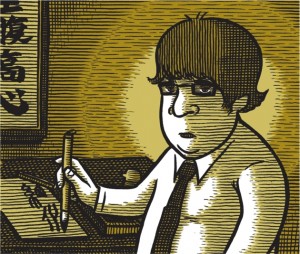Justin’s Japan: Interview with ‘Tonoharu’ Cartoonist/JET Alum Lars Martinson
By JQ magazine’s Justin Tedaldi (CIR Kobe-shi, 2001-02) for Examiner.com. Visit his NY Japanese Culture page here to subscribe for free alerts on newly published stories.
Minnesota-based cartoonist Lars Martinson went to Japan in 2003 to teach English on the JET Program, an exchange initiative sponsored by the Japanese government. During his three-year stay in rural Fukuoka, he was inspired to break ground on an ambitiously stylized four-part graphic novel named Tonoharu (Pliant Press) based on the trials and tribulations of living in Japan. Part Two was released in November, and I caught up with the artist to discuss the series so far and Japanese life through an expat’s eyes.
How would you describe the differences in Tonoharu: Part Two compared to the previous book? Did you do anything different in terms of storytelling or approach?
With each volume I’ve tried to explore different facets of living abroad. The first book focuses on the sense of loneliness and isolation that occurs after the “honeymoon period” of cultural acclimation ends. The second book deals with the relationships that develop, both with members of the native population and with other expats.
My approach to storytelling has gotten more deliberate as I’ve gone along. For Tonoharu: Part One, I started by writing “Page 1, Scene 1” at the top of a piece of paper and launching into a detailed script before I had a clear sense of what direction I wanted the story to go in. Diving straight into minutiae like that is like working on the interior design of a house that hasn’t been built yet; you should know how big the windows are before you pick out the curtains. So for Part Two—and now Part Three—I’ve given much more thought to the structure of the story, and made sure I was happy with the big picture before I got too wrapped up in details and nuance.
Tell us about your experiences on the JET Program. What made you choose to apply, and what was your overall take on the three years that you were there for?
When I was 16, I lived with a host family in Nagoya for a summer vacation exchange. The experience inspired a lifelong interest in international travel. I’d go on to live in Thailand and Norway for a year apiece as an exchange student, and visit a dozen or so other countries as a tourist. After I graduated from college, I wanted to try working abroad, and also wanted to return to Japan. A friend of mine introduced me to the JET Program, and I knew immediately that it was right for me. And sure enough, my three years in the JET Program were among the best I’ve ever had.
All JET participants hit high and low points while in Japan. What were some of yours?
My elementary school classes were among the most satisfying experiences. I planned all the lessons pretty much single-handedly, so once I got the hang of it, it was gratifying to see how excited the kids were about learning English, and how much they retained.
One of the more frustrating aspects of the experience, at least in the beginning, was the language barrier. It’s hard to form meaningful friendships when you can’t—y’know—talk to people. So it was always sad when I wanted to befriend someone and they clearly wanted to befriend me, but the logistics of not being able to communicate effectively got in the way.
Last summer, it was announced that the JET Program is facing sweeping budget cuts that may endanger its future. What’s your take on the value of the program in today in Japan and in the participants’ home countries?
I suppose with the economy being what it is, some cuts are probably inevitable. But I really hope they don’t gut the JET Program. My life has been enhanced beyond measure by having the opportunity to interact with foreign cultures, and I hope Japanese students will continue to be given the same opportunity. It’s hard to quantify the benefits of the JET Program, but that doesn’t really make them any less real or important.
What kind of feedback on the books have your received from JETs and those associated with the Japanese community?
I’ve tried to make the book accessible to readers regardless of their background, but it goes without saying that those who are familiar with Japan or the JET Program are able to appreciate it on a different level. JETs tend to pick up on all these little details in the books that other readers breeze pass without notice. I remember a JET alum commenting on a scene in Part One where the main character wears a fancy suit to his first day on the job, but since it’s summer vacation everyone else in the teacher’s room is wearing ratty gym clothes. It’s little things like that that you’d only consciously notice if you’d been in that situation yourself.
Click here for the rest of the interview.



Comments are closed.